The Seagate BarraCuda (500GB) SSD Review: Getting Back In The Game
by Billy Tallis on December 7, 2018 8:00 AM ESTMixed Random Performance
Our test of mixed random reads and writes covers mixes varying from pure reads to pure writes at 10% increments. Each mix is tested for up to 1 minute or 32GB of data transferred. The test is conducted with a queue depth of 4, and is limited to a 64GB span of the drive. In between each mix, the drive is given idle time of up to one minute so that the overall duty cycle is 50%.

The Seagate BarraCuda fares poorly on the mixed random I/O test, as do the other Phison S10 drives, even the PNY CS2211 with MLC NAND. The Plextor M8V is the next slowest drive with a mainstream controller, so it appears that the poor performance here from the Seagate BarraCuda is at least partly due to the NAND and is not just due to the Phison S10 controller.
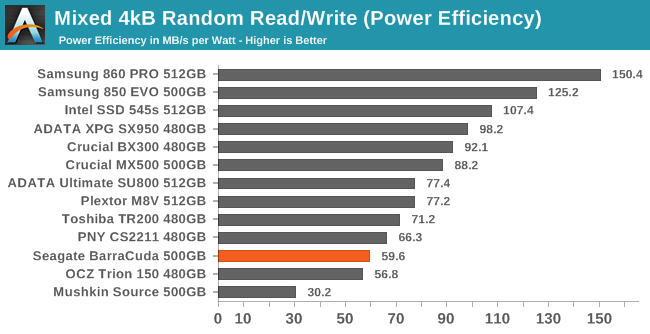 |
|||||||||
| Power Efficiency in MB/s/W | Average Power in W | ||||||||
Most mainstream SATA drives in this capacity class average around 1.5-1.6W during this test, so the efficiency rankings largely mirror the performance rankings. That leaves the BarraCuda again near the bottom of the chart.
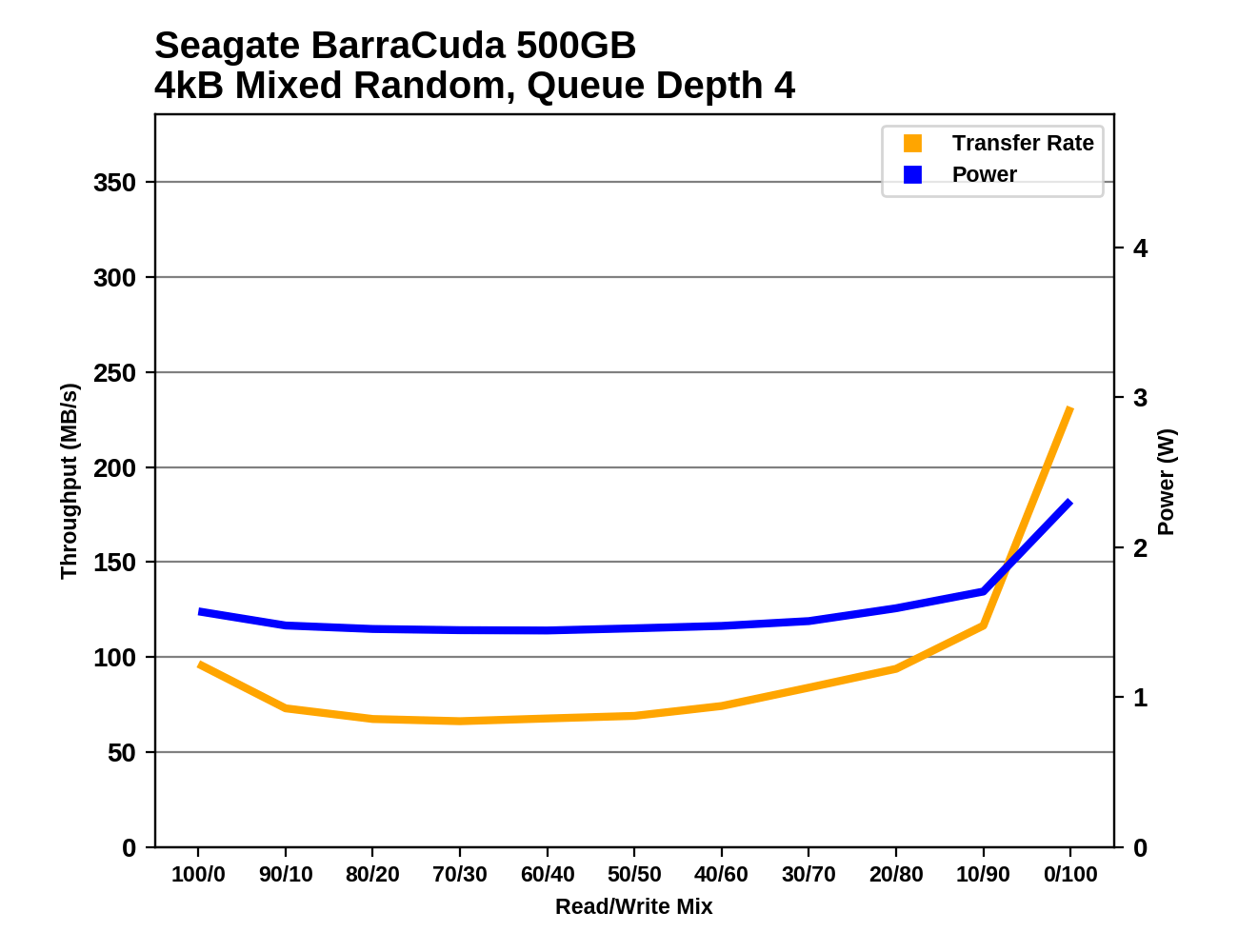 |
|||||||||
The fastest drives on this test are the ones that avoid performance drops when writes are added to the mix and instead steadily gain performance as the test progresses. The Seagate BarraCuda doesn't pull that off, with performance that drops when writes are first added to the mix and doesn't recover until near the end of the test when the workload is almost entirely writes.
Mixed Sequential Performance
Our test of mixed sequential reads and writes differs from the mixed random I/O test by performing 128kB sequential accesses rather than 4kB accesses at random locations, and the sequential test is conducted at queue depth 1. The range of mixes tested is the same, and the timing and limits on data transfers are also the same as above.
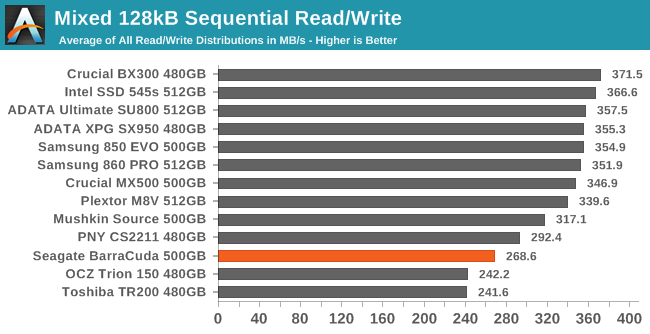
The Seagate BarraCuda had great sequential read performance and competitive sequential write performance, but it doesn't handle mixed sequential workloads all that well. As with the mixed random I/O test, the Phison S10 drives are all clustered at the bottom of the chart along with the DRAMless SSDs, while the other mainstream TLC SSDs offer at least 26% higher overall performance—and that comes from the Plextor M8V that uses the same Toshiba 3D TLC as the BarraCuda.
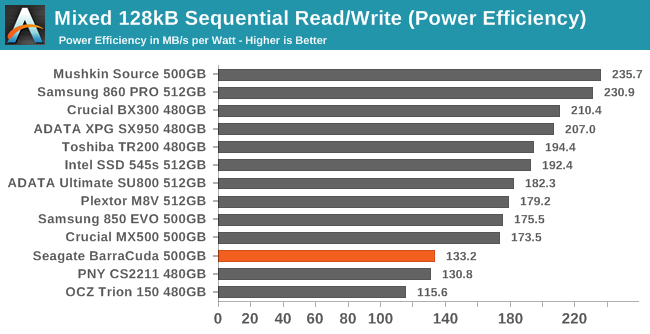 |
|||||||||
| Power Efficiency in MB/s/W | Average Power in W | ||||||||
The BarraCuda is again one of the most power-hungry drives, surpassed only by the Phison S10 SSDs that use planar NAND, so it earns one of the worst efficiency scores. The slow DRAMless SSDs at least manage to use far less power during this test, so they end up with pretty good efficiency scores.
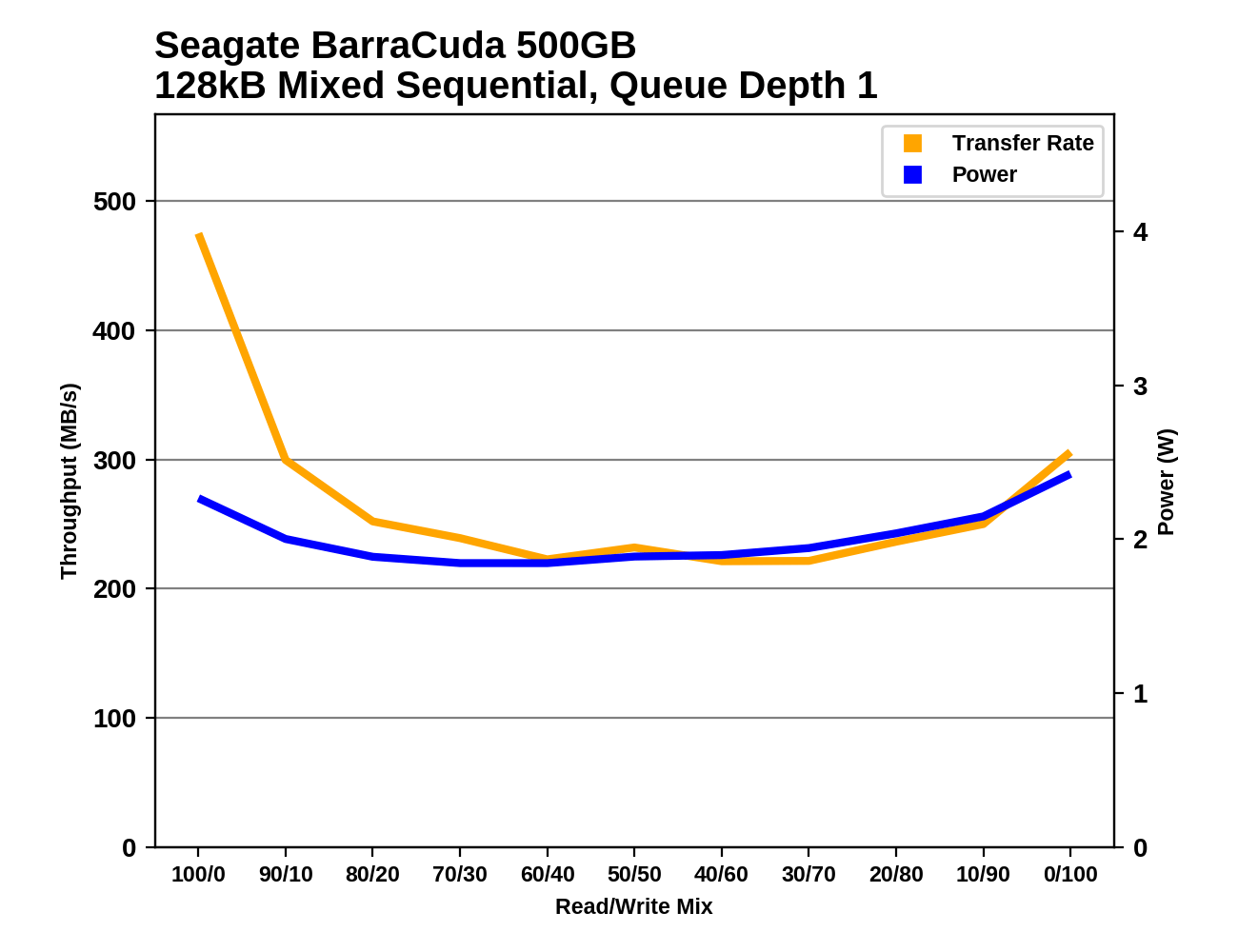 |
|||||||||
The BarraCuda starts off with great sequential read performance, but as soon as writes are added to the mix, throughput plummets. It stays slow through most of the test, recovering only slightly toward the end to deliver just over 300MB/s on pure writes. That final write speed isn't too bad, but most mainstream drives spend the read-heavy half of the test performing well above that level, instead of below 250MB/s.










39 Comments
View All Comments
Hulk - Friday, December 7, 2018 - link
Fantastic review as always. Thanks for your hard work.But I'm curious as to why the Samsung EVO 860 isn't in the benchmarks. It was recently selling for under $130 (not back at $150) and seems to be the benchmark to which most drives in this category should be compared?
Gasaraki88 - Friday, December 7, 2018 - link
The 850 EVO and 860 EVO are very similar in performance.Samus - Friday, December 7, 2018 - link
The problem for Samsung's consumer market is they've been making drives that max out the capabilities of SATA for 5 years. There just isn't much more room to improve.And the problem for Samsung's prosumer market is the WD Black NVMe is an overall better value than the 970 NVMe, ESPECIALLY in mobile where the 970's (even the EVO) are so power hungry they constantly throttle in laptops, while reducing battery life.
Samsung is riding on reputation right now. Superior products in the SATA space are irrelevant because at the high end you wont notice a real difference between SATA drives. And in the NVMe space, there are plenty of players on par with Samsung.
zodiacfml - Monday, December 10, 2018 - link
I used to think that SATA is dumb for recent SSDs. However, I noticed that it is only for sequential workloads which can be left running in the background. SATA still has a lot of life for SSDs.The 2.5" form factor is still dumb though. It is huge waste of space and materials.
Can't they make the case the size of the PCB using only the first pair of screws for mounting?
derekullo - Monday, December 10, 2018 - link
The reason this was done was to safe on space knowing that eventually they would deployed in laptops.Another reason was that when ssds were first being released with SLC, they were incredibly expensive and nobody could afford to buy your 1 Terabyte 3.5" drive filled to the brim with SLC nand. Of course we can afford it now ...
derekullo - Monday, December 10, 2018 - link
save on space* be deployed*Billy Tallis - Friday, December 7, 2018 - link
My smallest 860 EVO sample is 1TB, and I didn't want to put that on the graphs as the only drive of that capacity. Performance generally increases with drive capacity, so the 1TB would exaggerate the performance advantage of the 860 EVO over the BarraCuda (and probably slightly understate the efficiency advantage). You can make the comparison with our Bench tool if you're interested: https://www.anandtech.com/bench/product/2201?vs=21...Hulk - Friday, December 7, 2018 - link
Okay that makes sense.Death666Angel - Friday, December 7, 2018 - link
2.5" SATA SSDs should just become M.2 SATA SSDs with a caddy. :)Dragonstongue - Friday, December 7, 2018 - link
not everyone has m.2 on their boards and many of those boards overheat the drive in that slot anyways....t each own, "slow" drives are best kept as full out SATA sized drive (which vast majority are 2.5" anyways. the samsung 8/9xx are "unique" in that the pcb housing the memory chips etc is quite small compared to many so they "easily" put on a m.2 "gum stick"